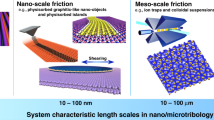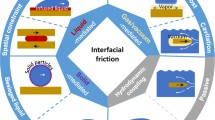Abstract
The friction at the liquid-solid interfaces is widely involved in various phenomena ranging from nanometer to micrometer scales. By the molecular dynamic (MD) simulation, the friction properties of liquid-solid interfaces at the molecular level are calculated via the Green-Kubo relation. It is found that the system size will influence the value of the friction coefficient, especially for the solid surfaces with the larger polar charge. The value of the friction coefficient decreases with the increase in the system size and converges at large system sizes. The large polar charge will lead to a significant friction coefficient. However, the diffusion of water molecules on this surface is almost a constant, indicating that the diffusion coefficient seems to be independent of the system size and polar charge. This work provides insights for the selection of the system size in modeling the frictional properties of hydrophobic/hydrophilic surfaces.
Similar content being viewed by others
References
SINGER, I. L. and POLLOCK, H. Fundamentals of Friction: Macroscopic and Microscopic Processes, Springer Science & Business Media, Dordrecht (1992)
AMPUERO, J. P. and BEN-ZION, Y. Cracks, pulses and macroscopic asymmetry of dynamic rupture on a bimaterial interface with velocity-weakening friction. Geophysical Journal International, 173, 674–692 (2008)
BOCQUET, L. and BARRAT, J. L. Flow boundary conditions from nano- to micro-scales. Soft Matter, 3, 685–693 (2007)
FALK, K., SEDLMEIER, F., JOLY, L., NETZ, R. R., and BOCQUET, L. Molecular origin of fast water transport in carbon nanotube membranes: superlubricity versus curvature dependent friction. Nano Letters, 10, 4067–4073 (2010)
TU, Y., LU, H., ZHANG, Y., HUYNH, T., and ZHOU, R. Capability of charge signal conversion and transmission by water chains confined inside Y-shaped carbon nanotubes. The Journal of Chemical Physics, 138, 015104 (2013)
WANG, J., CAO, W., MA, M., and ZHENG, Q. Enhanced diffusion on oscillating surfaces through synchronization. Physical Review E, 97, 022141 (2018)
HOLT, J. K., PARK, H. G., WANG, Y., STADERMANN, M., ARTYUKHIN, A. B., GRIGOROPOULOS, C. P., NOY, A., and BAKAJIN, O. Fast mass transport through sub-2-nanometer carbon nanotubes. Science, 312, 1034–1037 (2006)
ZHU, Y. and GRANICK, S. Rate-dependent slip of Newtonian liquid at smooth surfaces. Physical Review Letters, 87, 096105 (2001)
MA, M., TOCCI, G., MICHAELIDES, A., and AEPPLI, G. Fast diffusion of water nanodroplets on graphene. Nature Materials, 15, 66–71 (2016)
BRISCOE, W. H., TITMUSS, S., TIBERG, F., THOMAS, R. K., MCGILLIVRAY, D. J., and KLEIN, J. Boundary lubrication under water. Nature, 444, 191–194 (2006)
DRELICH, J., CHIBOWSKI, E., MENG, D. D., and TERPILOWSKI, K. Hydrophilic and superhydrophilic surfaces and materials. Soft Matter, 7, 9804–9828 (2011)
XIU, P., TU, Y., TIAN, X., FANG, H., and ZHOU, R. Molecular wire of urea in carbon nanotube: a molecular dynamics study. Nanoscale, 4, 652–658 (2012)
LUAN, B. and ZHOU, R. Wettability and friction of water on a MoS2 nanosheet. Applied Physics Letters, 108, 131601 (2016)
WANG, C., ZHOU, B., TU, Y., DUAN, M., XIU, P., LI, J., and FANG, H. Critical dipole length for the wetting transition due to collective water-dipoles interactions. Scientific Reports, 2, 358 (2012)
ZHANG, P., CHEN, Y. P., GUO, J. S., SHEN, Y., YANG, J. X., FANG, F., LI, C., GAO, X., and WANG, G. X. Adsorption behavior of tightly bound extracellular polymeric substances on model organic surfaces under different pH and cations with surface plasmon resonance. Water Research, 57, 31–39 (2014)
HUANG, S., HOU, Q., GUO, D., YANG, H., CHEN, T., LIU, F., HU, G., ZHANG, M., ZHANG, J., and WANG, J. Adsorption mechanism of mussel-derived adhesive proteins onto various self-assembled monolayers. RSC Advances, 7, 39530 (2017)
MARTINS, M., FONSECA, C., BARBOSA, M., and RATNER, B. Albumin adsorption on alkanethiols self-assembled monolayers on gold electrodes studied by chronopotentiometry. Biomaterials, 24, 3697–3706 (2003)
CHIEH, H. F., SU, F. C., LIAO, J. D., LIN, S. C., CHANG, C. W., and SHEN, M. R. Attachment and morphology of adipose-derived stromal cells and exposure of cell-binding domains of adsorbed proteins on various self-assembled monolayers. Soft Matter, 7, 3808–3817 (2011)
HUANG, K. and SZLUFARSKA, I. Green-Kubo relation for friction at liquid-solid interfaces. Physical Review E, 89, 032119 (2014)
GORB, S., GORB, E., and KASTNER, V. Scale effects on the attachment pads and friction forces in syrphid flies (Diptera, Syrphidae). Journal of Experimental Biology, 204, 1421–1431 (2001)
BOCQUET, L. and BARRAT, J. L. On the Green-Kubo relationship for the liquid-solid friction coefficient. The Journal of Chemical Physics, 139, 044704 (2013)
TOCCI, G., JOLY, L., and MICHAELIDES, A. Friction of water on graphene and hexagonal boron nitride from ab initio methods: very different slippage despite very similar interface structures. Nano Letters, 14, 6872–6877 (2014)
BOCQUET, L. and BARRAT, J. L. Hydrodynamic boundary conditions, correlation functions, and Kubo relations for confined fluids. Physical Review E, 49, 3079–3092 (1994)
CAO, W., WANG, J., and MA, M. Water diffusion in wiggling graphene membranes. The Journal of Physical Chemistry Letters, 10, 7251–7258 (2019)
MA, M., GREY, F., SHEN, L., URBAKH, M., WU, S., LIU, J. Z., LIU, Y., and ZHENG, Q. Water transport inside carbon nanotubes mediated by phonon-induced oscillating friction. Nature Nanotechnology, 10, 692–695 (2015)
VON HANSEN, Y., GEKLE, S., and NETZ, R. R. Anomalous anisotropic diffusion dynamics of hydration water at lipid membranes. Physical Review Letters, 111, 118103 (2013)
ERBASS, A., HORINEK, D., and NETZ, R. R. Viscous friction of hydrogen-bonded matter. Journal of the American Chemical Society, 134, 623–630 (2011)
SCHULZ, J. C., SCHMIDT, L., BEST, R. B., DZUBIELLA, J., and NETZ, R. R. Peptide chain dynamics in light and heavy water: zooming in on internal friction. Journal of the American Chemical Society, 134, 6273–6279 (2012)
WAN, R., LI, J., LU, H., and FANG, H. Controllable water channel gating of nanometer dimensions. Journal of the American Chemical Society, 127, 7166–7170 (2005)
SECCHI, E., MARBACH, S., NIGU S, A., STEIN, D., SIRIA, A., and BOCQUET, L. Massive radius-dependent flow slippage in carbon nanotubes. Nature, 537, 210–213 (2016)
BORMUTH, V., VARGA, V., HOWARD, J., and SCH FFER, E. Protein friction limits diffusive and directed movements of kinesin motors on microtubules. Science, 325, 870–873 (2009)
Author information
Authors and Affiliations
Corresponding author
Additional information
Project supported by the National Natural Science Foundation of China (Nos. 11605151, 11675138, and 11422542) and the Special Program for Applied Research on Super Computation of the NSFC-Guangdong Joint Fund (the second phase)
Rights and permissions
About this article
Cite this article
Zhao, L., Sun, J., Wang, X. et al. System-size effect on the friction at liquid-solid interfaces. Appl. Math. Mech.-Engl. Ed. 41, 471–478 (2020). https://doi.org/10.1007/s10483-020-2591-5
Received:
Revised:
Published:
Issue Date:
DOI: https://doi.org/10.1007/s10483-020-2591-5




